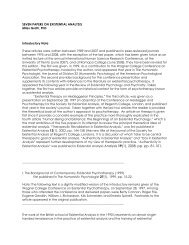The Sonate auf Concertenart: A Postmodern Invention? David ...
The Sonate auf Concertenart: A Postmodern Invention? David ...
The Sonate auf Concertenart: A Postmodern Invention? David ...
You also want an ePaper? Increase the reach of your titles
YUMPU automatically turns print PDFs into web optimized ePapers that Google loves.
<strong>Sonate</strong> <strong>auf</strong> <strong>Concertenart</strong>, p. 7<br />
My proposal is not intended to rule out the presence of sophisticated inter-generic<br />
references in Bach's chamber works and other late-Baroque music. But although interpretations<br />
along such lines may be unimpeachable as modern hearings of this repertory, they do not<br />
necessarily reflect the composer's intentions or the ways in which a contemporary listener would<br />
have understood the works in question. To be sure, we lack clear windows into early eighteenthcentury<br />
ways of hearing these pieces, but theoretical and critical writings, as well as titles and part<br />
rosters in original sources, provide a glimpse. From these it is evident that even the division<br />
between solo and tutti, so fundamental to modern views of the concerto, was relatively<br />
insignificant from some early eighteenth-century perspectives. Hence apparent allusions to the<br />
solo-tutti distinction may not have served as markers of the concerto in works such as the two<br />
sonatas illustrated above. Indeed, which if any of what are now thought to be the conventions of<br />
concerto writing were well defined around 1713, when Bach is thought to have begun<br />
transcribing instrumental concertos for keyboard instruments? 10<br />
<strong>The</strong> problem deepens when one attempts to identify precisely which passages in a given<br />
sonata movement correspond to the tutti and solo passages--that is, the ritornellos and the solo<br />
episodes--of an archetypal concerto movement. <strong>The</strong> exercise often begins simply, as in the outset<br />
of the two works shown in examples 1 and 2. But as the music proceeds, different listeners are<br />
11<br />
apt to reach different conclusions as to which passage represents which part of a concerto. <strong>The</strong><br />
problem is not confined to works of J. S. Bach, and although it might be ascribed to deliberate<br />
genre blurring, it is logical at least to reconsider the underlying premise that individual passages in<br />
such movements serve as functional equivalents for either the "solo" or the "tutti" (or "ritornello")<br />
sections of a concerto.<br />
Tomaso Albinoni's Mature Concertos," in Bach Studies 2, ed. Daniel R. Melamed (Cambridge:<br />
Cambridge University Press, 1995), 24-5, traces the use of a "double Devise" in Bach's concerto<br />
movements not to "his own da capo aria" but to the "characteristic" use of this technique in the<br />
later concertos of Albinoni.<br />
10<br />
<strong>The</strong> now-customary dating of these works depends on the argument of Hans-Joachim<br />
Schulze that Bach's opportunities for studying and playing the works of Vivaldi and others<br />
probably broadened considerably in 1713, when Prince Johann Ernst of Sachsen-Weimar returned<br />
from university studies in Utrecht; see his Studien zur Bach-Überlieferung im 18. Jahrhundert<br />
(Leipzig: Edition Peters, 1984), pp. 146ff. Karl Heller raises the possibility of Bach's work having<br />
taken place over a more extended period, noting the existence of alternate versions; see his<br />
Kritischer Bericht to Johann Sebastian Bach: Bearbeitungen fremder Werke: Concerti BWV<br />
972-87, 592a; <strong>Sonate</strong>n BWV 965, 966, Fuga BWV 954, in Johann Sebastian Bach: Neue Ausgabe<br />
sämtlicher Werke, Serie V, Band 11 (Kassel: Bärenreiter, 1997), 18-19. One might also point to<br />
considerable differences in the degree to which the individual concertos are reworked for<br />
keyboard performance.<br />
11 See, for example, the differing analyses of the first movement of Bach's A-major flute<br />
sonata BWV 1032 by Marissen and Swack in the articles cited above.















